Accepted Scientific Name: Rebutia minuscula K.Schum.
Monatsschr. Kakteenk. 5: 102, cum xylogr. 1895

Rebutia violaciflora var. albispina Photo by: Valentino Vallicelli
Origin and Habitat: Garden origin (Violet flowering form)
Synonyms:
See all synonyms of Rebutia minuscula
back
Accepted name in llifle Database:Rebutia minuscula K.Schum.Monatsschr. Kakteenk. 5: 102, cum xylogr. 1895Synonymy: 65
back
Description: Rebutia violacifloraSN|15395]]SN|15442]] var. albispina is one of the many forms of the extremely variable Rebutia minusculaSN|15395]]SN|15391]]. It has peculiar pink-violet flowers and bright glassy-white spines somewhat intermediate between the short, bristle-like spines of Rebutia minusculaSN|15391]]SN|15391]] and the fairly long, flexible spines of Rebutia senilisSN|15391]]SN|15395]]. It is very similar to Rebutia senilisSN|15442]]SN|15395]] var. lilacino-rosea|SN|15484]] Backeberg, but spines are usually longer and whiter.
Habitat: It is solitary or clumping and in age can grow clumps 10-15 cm wide. Each head is surrounded by a complete ring of pink-violet flowers produced from around the base of the plant. It begins to offset in about its third or fourth year, eventually making a moderately tight clump, with the individual stems standing out a little on their own.
Roots: Fibrous.
Stem: Squat, depressed globose (or somewhat spherical to slightly elongated in cultivation), deep green, up to 7 cm in diameter and 4-6 (or more) cm tall.
Ribs: 16-21 spiralling with low, vertical or slightly spiralled with distinct tubercles.
Tubercles: Low, flat conical in two downward spirals, in ratio 8:13.
Areoles: Circular, about 1 mm wide, white tomentose.
Spines: Approximately 25, radiating to upright, hardly distinguishable as radials and central, variable, short bristle-like, flexible, 5-10 mm long, pure white and translucent.
Flowers: It produces a larger crop of funnel-shaped pink-violet flowers, about 30 mm long and 35 mm wide. Filaments whitish, anthers yellowish. Style free to base pink with 4-5 white, spreading stigma lobes slightly protruding above the anthers.
Blooming season: Flowers all tend to come in one Spring rush, rather than spread over the Summer. It is usually one of the earliest rebutias to flower in spring.
Fruit: Spherical, yellowish red or brownish, to 5 mm in diameter.
Subspecies, varieties, forms and cultivars of plants belonging to the Rebutia minuscula group
- Rebutia chrysacantha Backeb.: This name is applied to plants with stiffer spines, yellowish with brown tips, and with reddish-orange flowers.
 Rebutia chrysacantha var. elegans (Backeb.) Backeb.: has stiff whitish spines and reddish-orange flowers. The name is derived from the overall appearance of the variety, with elegant, neat, spines spirally arranged.
Rebutia chrysacantha var. elegans (Backeb.) Backeb.: has stiff whitish spines and reddish-orange flowers. The name is derived from the overall appearance of the variety, with elegant, neat, spines spirally arranged.- Rebutia grandiflora Backeb.
 Rebutia minuscula K.Schum.: is a small clumping cactus species, widespread and extremely variable. Flowers orange-red to violet. Distribution: northern Argentina (Catamarca, Jujuy, Salta and Tucumán)
Rebutia minuscula K.Schum.: is a small clumping cactus species, widespread and extremely variable. Flowers orange-red to violet. Distribution: northern Argentina (Catamarca, Jujuy, Salta and Tucumán)  Rebutia minuscula subs. edeltraudianae n.n.: has yellow-orange flowers (= Rebutia xanthocarpa). Distribution: Sierra Medina, Tucuman, Argentina.
Rebutia minuscula subs. edeltraudianae n.n.: has yellow-orange flowers (= Rebutia xanthocarpa). Distribution: Sierra Medina, Tucuman, Argentina. Rebutia minuscula f. kariusiana (Wessner) Donald: has pink-violet flowers and shows transitional characters between Rebutia minuscula subs. violaciflora and Rebutia wessneriana subs. beryllioides.
Rebutia minuscula f. kariusiana (Wessner) Donald: has pink-violet flowers and shows transitional characters between Rebutia minuscula subs. violaciflora and Rebutia wessneriana subs. beryllioides. Rebutia senilis Backeb.: has bristly, glassy, white spines up to 30 mm long that largely covers the stems and very showy orange or crimson blooms. Distribution: Salta, Argentina.
Rebutia senilis Backeb.: has bristly, glassy, white spines up to 30 mm long that largely covers the stems and very showy orange or crimson blooms. Distribution: Salta, Argentina. Rebutia senilis var. iseliniana Krainz: has bright orange or orange-red (occasionally yellow) flowers and thinner spines, sometimes pure white, often with a yellowish cast.
Rebutia senilis var. iseliniana Krainz: has bright orange or orange-red (occasionally yellow) flowers and thinner spines, sometimes pure white, often with a yellowish cast. Rebutia senilis var. lilacino-rosea Backeb.: has pink-violet flowers that distinguishes it from other varieties of Rebutia senilis.
Rebutia senilis var. lilacino-rosea Backeb.: has pink-violet flowers that distinguishes it from other varieties of Rebutia senilis. Rebutia violaciflora Backeb.: has light-violet blossoms in the early spring. It is a selected colour strain.
Rebutia violaciflora Backeb.: has light-violet blossoms in the early spring. It is a selected colour strain. Rebutia violaciflora var. albispina hort.: has pink-violet flowers and glassy-white spines intermediate between the short, spines of Rebutia minuscula and the long spines of Rebutia senilis.
Rebutia violaciflora var. albispina hort.: has pink-violet flowers and glassy-white spines intermediate between the short, spines of Rebutia minuscula and the long spines of Rebutia senilis.- Rebutia violaciflora var. carminea (Buining) Donald
- Rebutia xanthocarpa var. graciliflora Backeb. ex Šída
Bibliography: Major references and further lectures
1) Edward Anderson “The Cactus family” Timber Press, Incorporated, 2001
2) James Cullen, Sabina G. Knees, H. Suzanne Cubey "The European Garden Flora Flowering Plants: A Manual for the Identification of Plants Cultivated in Europe, Both Out-of-Doors and Under Glass" Cambridge University Press, 11/Aug/2011
3) David R Hunt; Nigel P Taylor; Graham Charles; International Cactaceae Systematics Group. "The New Cactus Lexicon" dh books, 2006
4) N. L. Britton, J. N. Rose “The Cactaceae. Descriptions and Illustrations of Plants of the Cactus Family.” Volume 4, The Carnegie Institution of Washington, Washington 1923
5) Curt Backeberg “Die Cactaceae: Handbuch der Kakteenkunde” Gustav Fischer Verlag, Stuttgart New York 1982–1985
6) Willy Cullmann, Erich Götz, Gerhard Gröner “Kakteen” edn 5 - Stuttgart Eugen Ulmer, 1984
7) Backeberg, Curt; "Das Kakteenlexikon" p. 384, 1966
8) Donald, John Donald; "The Classification of the Rebutias" Ashingtonia, 2: 43, 1975
9) Hlinecký, Antonín; "Rod Rebutia K. Schumann"; Fričiana, 5/36: 9, 1965
10) Krainz, Hans; "Rebutia minuscula K. Schumann; Die Kakteen", CVc, 15.7.1960
11) Pilbeam, John; "Rebutia", p. 57, 1997
12)Schumann, Karl Moritz; "Gesamtbeschreibung der Kakteen", p. 395, 1898
13) Šída, Otakar; "Atlas kaktusů", tab. 50, 1991
14) Šída, Otakar; "Rod Rebutia", p. 31, 1997
15) Demaio, P., Lowry, M., Ortega-Baes, P., Perea, M. & Trevisson, M. 2013. Rebutia minuscula. In: IUCN 2013. "IUCN Red List of Threatened Species." Version 2013.2. <www.iucnredlist.org>. Downloaded on 06 January 2014.
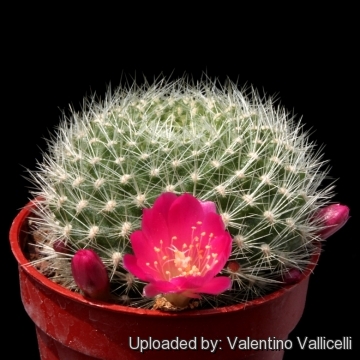 Rebutia violaciflora var. albispina Photo by: Valentino Vallicelli
Rebutia violaciflora var. albispina Photo by: Valentino Vallicelli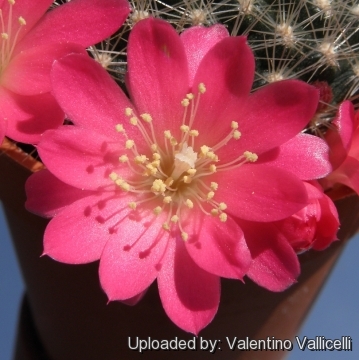 Rebutia violaciflora var. albispina Photo by: Valentino Vallicelli
Rebutia violaciflora var. albispina Photo by: Valentino Vallicelli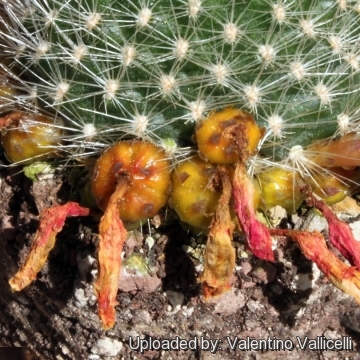 Rebutia violaciflora var. albispina Photo by: Valentino Vallicelli
Rebutia violaciflora var. albispina Photo by: Valentino Vallicelli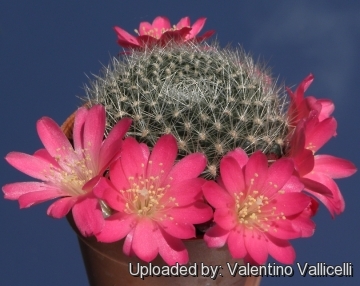 Rebutia violaciflora var. albispina Photo by: Valentino Vallicelli
Rebutia violaciflora var. albispina Photo by: Valentino Vallicelli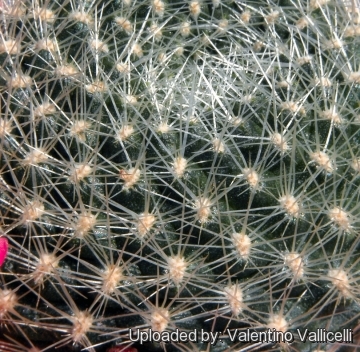 Rebutia violaciflora var. albispina Photo by: Valentino Vallicelli
Rebutia violaciflora var. albispina Photo by: Valentino Vallicelli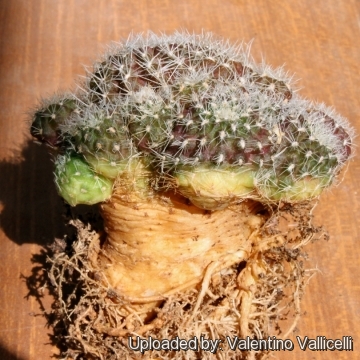 Rebutia violaciflora var. albispina Photo by: Valentino Vallicelli
Rebutia violaciflora var. albispina Photo by: Valentino VallicelliCultivation and Propagation: Rebutia violacifloraSN|15391]]SN|15442]] var. albispina is a summer grower species that is easy to cultivate and recommended for beginners. The whole Rebutia minusculaSN|15442]]SN|15391]] complex has delightful flowers and the plants remain compact, and clumps can easily be managed by division. Another advantage is that the plants are very cold hardy in Winter if kept dry.
Growth rate: It is a slow growing but easily flowering species that will make clumps given the best conditions.
Soils: It likes very porous standard cactus mix soil with a pH slightly on the acidic side.
Repotting: This species will occupy a small flower pot comfortably and remain a manageable sized house plant, repotting should be done every other year or when the it has outgrown its pot. Use pot with good drainage.
Watering: Needs moderate to copious waterings in summer, but do not overwater (the root system is rot prone) and allow the pot to dry out between waterings. Keep dry in winter at a minimum temperature of 0°C.
Fertilization: Feed with a high potassium fertilizer in summer.
Hardiness: It is reputedly resistant to frost if kept on the dry side prior to, and during, cold weather and requires a winter rest period (hardy to -7 C ° C, or less for short periods), but for safe cultivation it is best to avoid freezing temperatures. It does not like high temperatures in summer, and will be perfectly happy in pots outdoors from April to September if protected from torrential rain and hail
Exposition: The plant tolerates extremely bright situations but enjoys filtered sunlight or afternoon shade, inside it needs bright light, and some direct sun. Tends to bronze in strong light, which encourages flowering and heavy spine production, but is likely to suffer from sun scorch or stunted growth if over exposed to direct sunlight during the hottest part of the day in summer.
Uses: It is an excellent plant for container growing. It always looks good and stays small. It look fine in a cold greenhouse and frame or outdoor in a rockery.
Pests & diseases: It may be attractive to and liable to damage by spider mites and thrips
but plants in good condition should be nearly pest-free, particularly if they are grown in a mineral potting-mix, with good exposure and ventilation.
Rot: This species is particularly easy and accommodating, seldom suffer of cryptogamic diseases. Rot it is only a minor problem with rebutias if the plants are watered and “aired” correctly. If they are not, fungicides won't help all that much.
Propagation: Division, direct sow after last frost. Seeds germinate in 7-14 days at 21-27° C in spring, remove gradually the glass cover as soon the plants will be well rooted (ca 1-2 weeks) and keep ventilated, no full sun for young plants! To make a cutting twist off a branch and permit it to dry out a couple of weeks, lay it on the soil and insert the stem end partially into the soil. Try to keep the cutting somewhat upright so that the roots are able to grow downward.
Note: It would appear that in cultivation they grow larger and cluster more vigorously than in habitat.
















